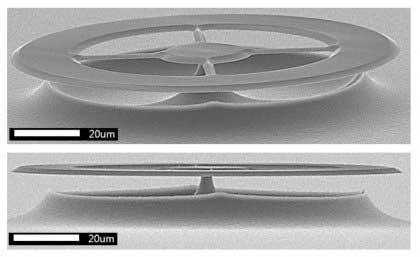| Jan 15, 2019 | |
Nanofabricated ultra ultrasound to revolutionize technology(Nanowerk News) A new and extremely sensitive method of measuring ultrasound could revolutionise everything from medical devices to unmanned vehicles. |
|
| Researchers at The University of Queensland have combined modern nanofabrication and nanophotonics techniques to build the ultraprecise ultrasound sensors on a silicon chip (Nature Communications, "Precision ultrasound sensing on a chip"). | |
 |
|
| Nanofabricated ultraprecise ultrasound sensors on a silicon chip. (Image: University of Queensland) | |
| Professor Warwick Bowen, from UQ’s Precision Sensing Initiative and the Australian Centre for Engineered Quantum Systems, said the development could usher in a host of exciting new technologies. | |
| “This is a major step forward, since accurate ultrasound measurement is critical for a range of applications,” he said. | |
| “Ultrasound is used for medical ultrasound, often to examine pregnant women, as well as for high resolution biomedical imaging to detect tumours and other anomalies. | |
| “It’s also commonly used for spatial applications, like in the sonar imaging of underwater objects or in the navigation of unmanned aerial vehicles. | |
| “Improving these applications requires smaller, higher precision sensors and, with this new technique, that’s exactly what we’ve been able to develop.” | |
| The technology is so sensitive that it can hear, for the first time, the miniscule random forces from surrounding air molecules. | |
| “We’ve developed a near perfect ultrasound detector, hitting the limits of what the technology is capable of achieving,” Professor Bowen said. | |
| “We’re now able to measure ultrasound waves that apply tiny forces – comparable to the gravitational force on a virus – and we can do this with sensors smaller than a millimetre across.” | |
| Research leader Dr Sahar Basiri-Esfahani, now at Swansea University, said the accuracy of the technology could change how scientists understand biology. | |
| “We’ll soon have the ability to listen to the sound emitted by living bacteria and cells,” she said. | |
| “This could fundamentally improve our understanding of how these small biological systems function. | |
| “A deeper understanding of these biological systems may lead to new treatments, so we’re looking forward to seeing what future applications emerge.” |
| Source: University of Queensland | |
|
Subscribe to a free copy of one of our daily Nanowerk Newsletter Email Digests with a compilation of all of the day's news. |
